How to build a website like Etsy from scratch
Etsy is one of the biggest marketplaces in the world, connecting millions of artisans with customers across the globe. This guide takes you through the process of building a website like Etsy – from establishing your business model to building a secure, scalable platform.
Etsy is one of the most successful examples of a peer-to-peer product marketplace. It connects millions of makers and vintage sellers with buyers who value creativity, sustainability, and one-of-a-kind finds.
In 2024, Etsy generated more than $2.8 billion in total revenue, with 72% coming from the marketplace.
So what makes Etsy such an inspiring model for marketplace founders today? It taps into the surging creator economy, rides the wave of sustainable consumption, and thrives on the loyalty of tight-knit seller and buyer communities. Plus, with today’s no-code and modular marketplace platforms, launching a similar venture is easier and more cost-effective than ever.
This guide lays out exactly how to do it. You’ll learn how Etsy’s model works, what drives its success, and how to validate, design, and launch your own version step by step. We’ll also share real-world examples of other marketplaces, cost estimates from idea to launch, and key strategies for growth.
Etsy is well-known as a truly global marketplace. The platform counts over 95 million buyers and over 8 million sellers worldwide. In 2024 alone, Etsy powered over $12.6 billion in gross merchandise sales.
But it wasn’t always this way.
In 2005, Etsy founder Rob Kalin was an amateur furnituremaker struggling to sell his furniture online. He partnered with Haim Schoppik and Chris Maguire to build Etsy, and within a few months, thousands of artisans and crafters had joined the platform.
Today, Etsy is a public company valued at north of $6 billion. It’s one of the most successful peer-to-peer marketplaces in history, alongside giants like Airbnb and Uber.
While it’s taken Etsy nearly 20 years to get to this scale, it’s now easier than ever to build your own marketplace business. There are three key reasons why.
First of all, marketplace companies are growing fast. Founders have great opportunities to build and scale their own marketplace businesses. The secret of success for the next wave of marketplaces like Etsy is to specialize and focus. Sharetribe customers have seen great success with marketplaces strictly focused on artisans and handmade items, like Handmade.com.
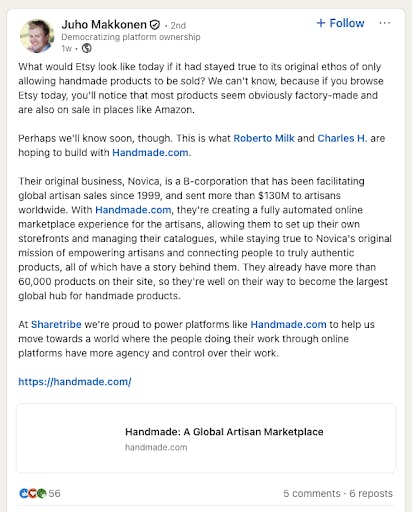
Second, you don’t need a five-figure budget to start a marketplace. In traditional e-commerce, the business owner usually takes a risk by investing in initial inventory. With marketplaces like Etsy, there’s no need to buy supply, negotiate contracts with suppliers, or manage logistics. Instead, the users of your marketplace do that for themselves.
Third, building a marketplace site like Etsy has never been easier. With software like Sharetribe, it’s easy to launch quickly and validate your idea. When it’s time to level up, the software also gives you the power to add custom features at a fraction of the cost of building a marketplace platform from scratch.
But more on what we offer at Sharetribe later. Next, we’ll outline how a marketplace like Etsy works and what that means for how you’ll build your own business.
Etsy is an e-commerce marketplace. This means that unlike traditional single-vendor e-commerce stores, it doesn’t buy, manufacture, or ship products—that is handled by sellers. It simply provides the infrastructure to connect buyers and sellers and help small businesses flourish.
To understand what makes Etsy unique, it helps to break down its business model into clear components.
When sellers sign up to Etsy, they get access to a huge pool of potential customers. It’s easy to get started: sellers make a profile, create a listing for each product, and pay Etsy a $0.20 fee for each listed item. Once that’s done, the seller’s Etsy store is live.
Buyers discover products and stores by browsing categories or searching for specific items. Each product listing page has images, a description of the product, and reviews from previous buyers.
Marketplace websites like Etsy are much more complex than regular eCommerce sites.
The checkout process is simple. Etsy handles all payments, with a sophisticated infrastructure that accepts payments in different currencies and guarantees secure transactions.
Once the buyer receives their item, Etsy encourages them to review it. In the past, Etsy sellers were also asked to review buyers, but this feature has now been removed. Many two-sided marketplaces (like Airbnb, for example) still have this feature to increase trust between users.
Etsy’s revenue model is simple. The marketplace makes money in five main ways:
- Listing fees: Sellers are charged a $0.20 listing fee every time they list a new item.
- Commission: Every time a seller makes a sale, Etsy takes 6.5% from the transaction as a commission.
- Subscriptions: Sellers can join Etsy Plus for $10/month to access additional tools and features.
- Ads: Sellers pay Etsy to make their products more visible in search results.
- Etsy Payments: Sellers can enroll in Etsy Payments to process payments from buyers. Fees vary by country, but tend to be around 3–5% of the gross purchase price.
Other models that aspiring marketplace entrepreneurs could consider include membership fees, lead fees, or freemium models. To learn more, read our guide to choosing the right marketplace business model.
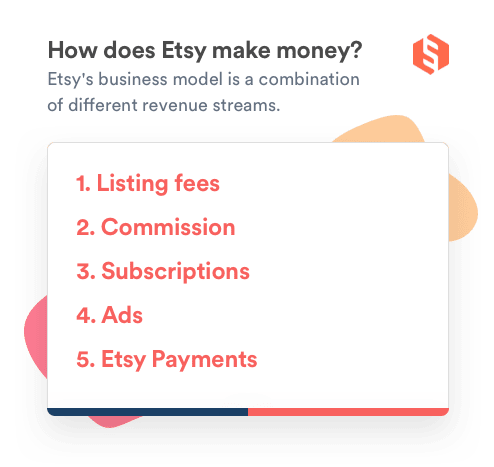
Choosing the right business model and determining the right marketplace pricing strategy are critical decisions that can make or break your business.
Low fees might attract sellers to the platform, but marketplaces must generate revenue to maintain the platform, add new features, and pay employees. Equally, fees and upfront costs can’t be too high, or sellers won’t sign up for the platform. Striking the right balance is crucial to the success of any marketplace business.
Update your business model as your marketplace grows. Commission models are most attractive at first, as they keep costs low for new sellers. As more users join the platform, you can consider introducing new revenue streams like listing fees or paid advertising to diversify your business.
Etsy’s business model prioritizes makers and buyers equally. Etsy built a massive supply of unique, handcrafted products by keeping fees low for sellers and making it easy for them to get started. On the buyer side, Etsy invested in discovery—optimizing search, navigation, and mobile design—so shoppers could easily find items in an otherwise overwhelming catalog.
Here are some of the core elements that have fueled Etsy’s success:
- Low seller friction: With just a $0.20 listing fee and a 6.5% transaction fee, sellers face minimal upfront costs. Etsy also doesn’t require inventory buy-in, which reduces barriers for small businesses.
- Trust infrastructure: Seller profiles, verified payments, a strong review culture, and copyright enforcement policies give users confidence in every transaction.
- Community and curation: Etsy positions itself as a home for creativity and sustainability to build loyalty around shared values rather than price competition.
- Discovery UX: Personalized search results, intuitive category navigation, and Pinterest-style visuals help buyers discover products that match their taste.
- Mobile majority: Over 60% of Etsy sales happen on mobile devices, emphasizing the importance of a smooth mobile experience for growth.
Etsy has scaled a peer-to-peer marketplace while keeping its community feel intact, thanks to a mix of seller-friendly economics and buyer-focused design.
At the same time, many artisan sellers have grown frustrated with increasing competition from mass-produced goods. That frustration has become a recurring theme in seller forums and press coverage, and it represents a real opportunity for emerging marketplaces.
All of the marketplaces below are built with Sharetribe. Each one shows how founders can take the same peer-to-peer model as Etsy and adapt it to a specific niche, whether that’s sustainable fashion, local artisans, or curated vintage.
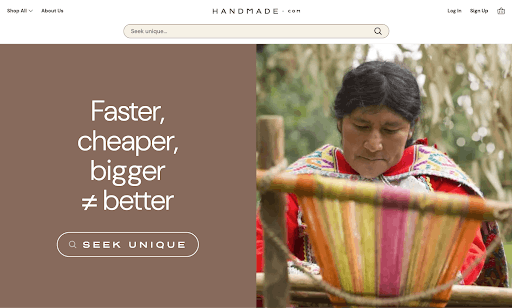
Handmade.com is a marketplace with a mission to empower artisans and connect people to authentic products. The company behind the platform, Novica, is a B-corporation that has been facilitating global artisan sales since 1999.
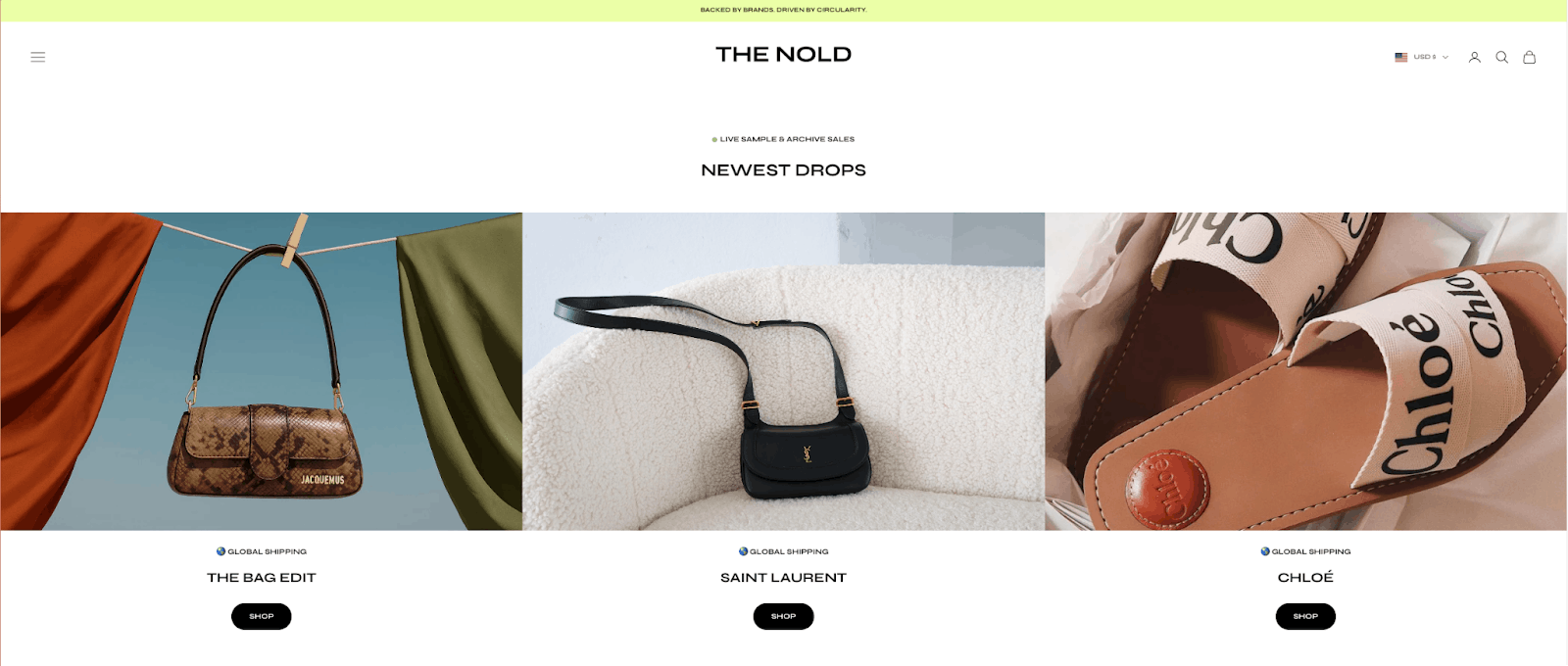
The Nold is a sustainable fashion marketplace where users can buy and sell secondhand clothes from their closets. Focused on circular fashion, it makes it easy for people to refresh their wardrobes while reducing textile waste.
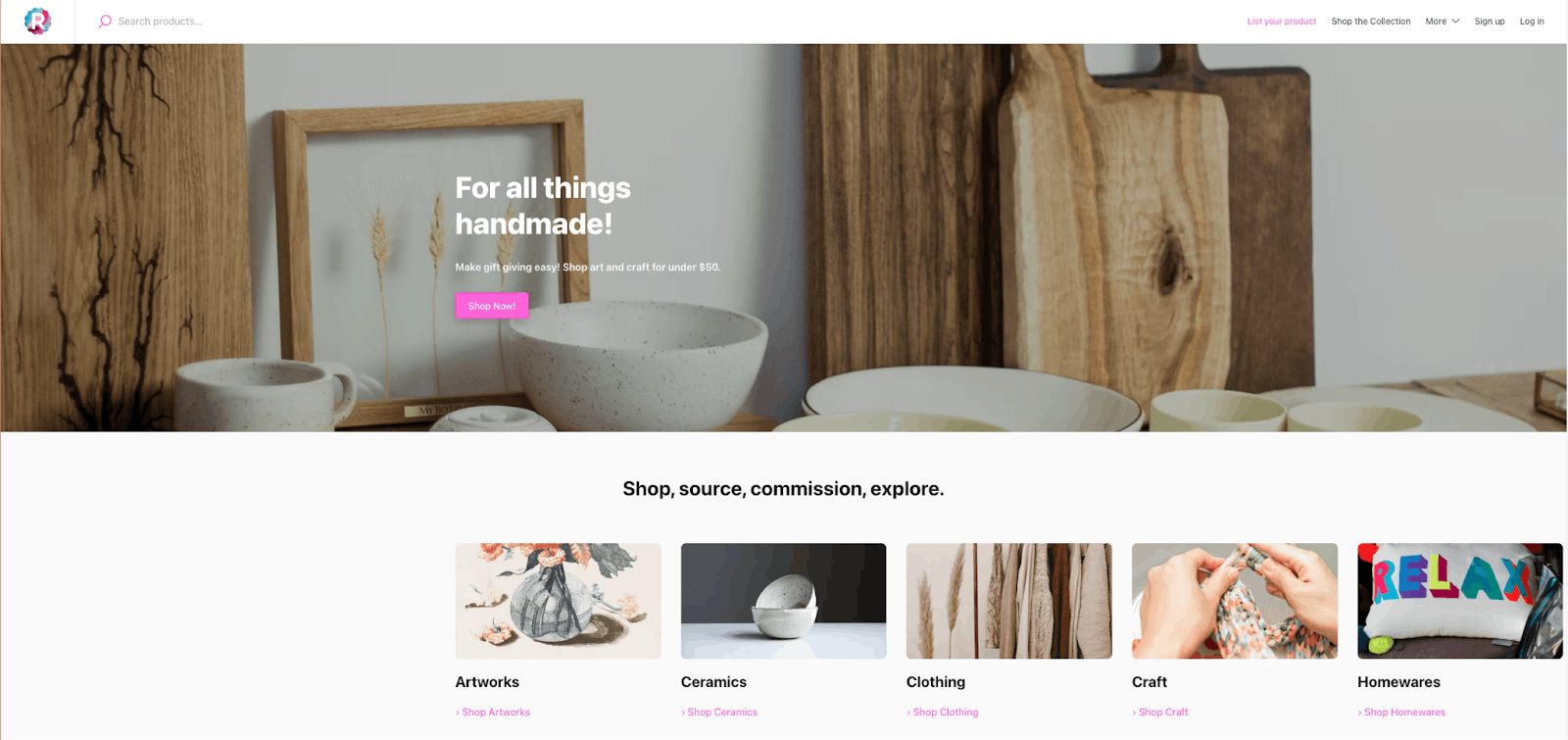
Based in Melbourne, Rose Street Store is a curated marketplace for handmade goods. Local artists and designers showcase their creations, from jewelry to home décor, while shoppers get a direct connection to the makers behind the products.

Rowely is a vintage and preloved fashion marketplace designed for secondhand occasion wear. Its clean, modern interface helps buyers discover high-quality pieces and allows sellers to reach fashion-conscious audiences.

Truzeau connects conscious consumers with new and gently used South Asian fashion. Its marketplace brings together independent sellers offering eco-friendly, handmade, and vintage goods to help buyers shop ethically without sacrificing style.
Building a marketplace like Etsy may sound daunting, but breaking it into clear steps makes the process manageable. Let’s walk through the necessary steps for bringing your Etsy-style marketplace to life.
Competing directly with Etsy is hard. They’re a huge, established player with millions of sellers and buyers all over the world.
But you don’t have to build a site that’s exactly like Etsy.
Instead, start small and build a memorable experience for a targeted group of users.
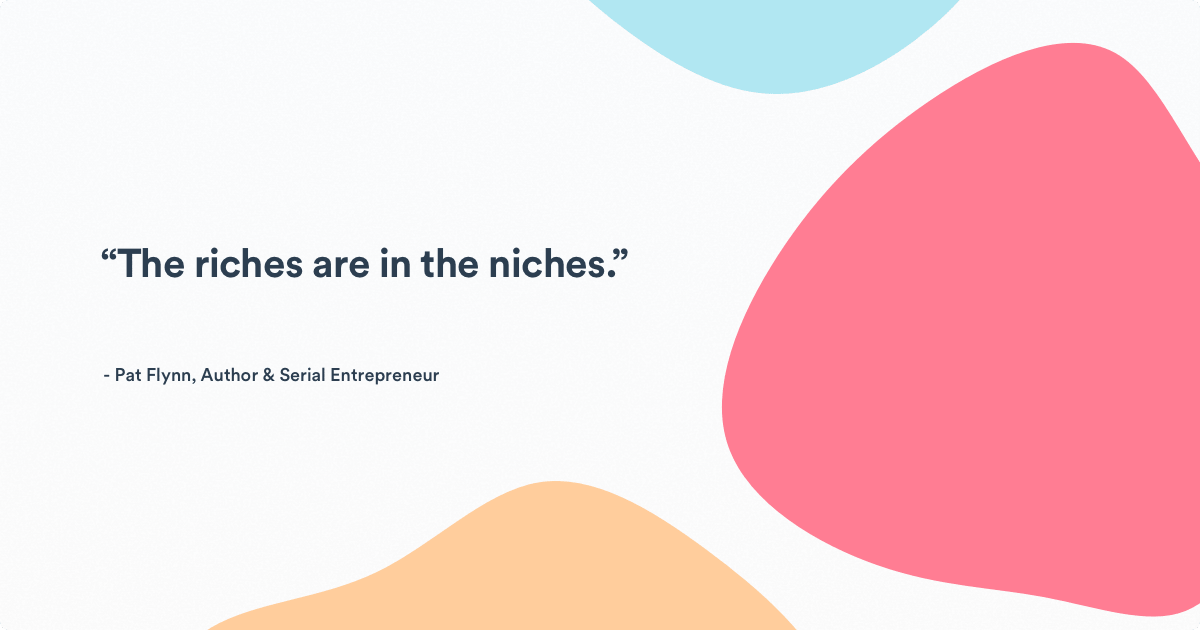
New marketplaces that try to reach everybody often reach nobody. Specialized marketplaces speak to a small, defined audience. This focus enables entrepreneurs to build a differentiated platform that delivers a winning customer experience for the core target market.
For inspiration, read our interview with Robin Chase, co-founder of Zipcar, who shares her perspective on spotting big opportunities by starting small. You can also check out our guide to coming up with the next great marketplace idea.
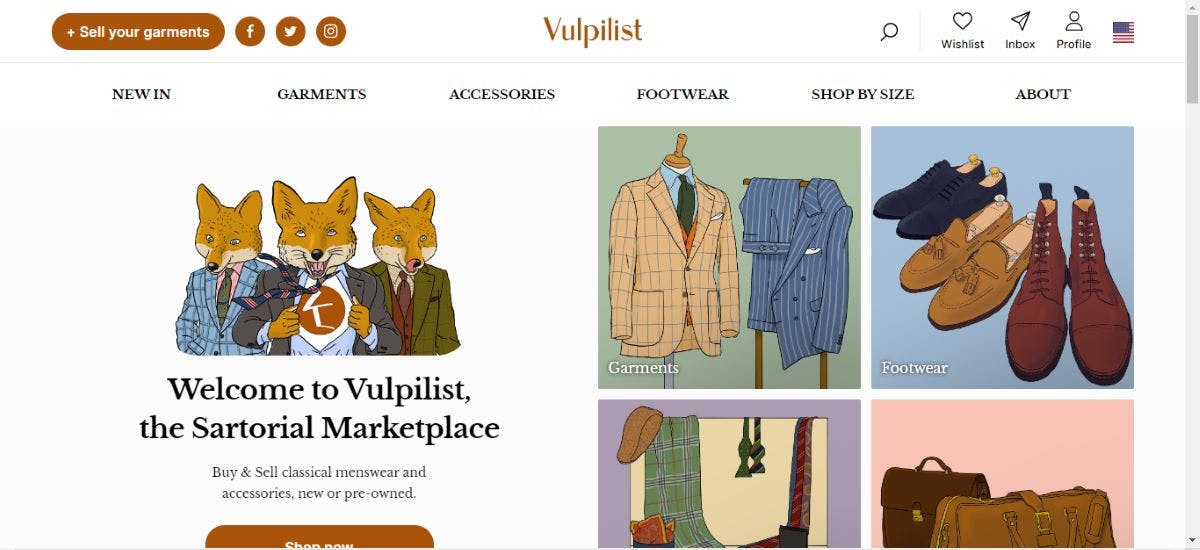
Knowing how to target the right niche can be challenging. Fortunately, it’s easy to validate your idea before committing to building it.
Test early to avoid investing in something nobody wants, refine your unique value proposition, and even start building your initial supply. Most importantly, validation accelerates your path to problem-solution fit, which is essential before you can grow (more on this later).
Here are some of the best ways to validate your idea:
- Talk to your target audience: Interview potential buyers and sellers to learn what pain points matter most.
- Test demand signals: Use free tools like Google Trends to see if people are actively searching for products in your niche.
- Leverage existing communities: Platforms like Facebook Groups or Reddit can help you gauge interest and gather feedback.
- Experiment quickly: Instead of waiting for a full launch, it’s often better to validate as you go with small, low-cost experiments.
In the end, there’s only so much that research will tell you. The best way to validate your idea is to build your marketplace platform and launch as early as possible. Luckily, it’s easy to build a handmade website like Etsy quickly, without coding.
Before adding advanced functionality, focus on building a Minimum Viable Platform (MVP). An MVP helps you launch quickly and start testing your ideas with just the core features required to connect buyers and sellers.
Instead of spending months or years building every possible feature, you can get your marketplace in front of users early, gather feedback, and iterate based on what matters most. For a deeper dive into this approach, see our guide to building a marketplace MVP.
Marketplace websites are much more complex than regular e-commerce sites. Online marketplaces like Etsy need features for buyers, sellers, and marketplace administrators.
Here are the key features to consider if you want to make a website like Etsy:
Profiles
Profiles build trust between marketplace users. Both buyers and sellers should create profiles. Seller profiles showcase all of their product listings and reviews on one page. These can be thought of as the seller’s digital storefront.
Listing pages
Every product should have its own listing. These pages let sellers share detailed product information with potential buyers.
Product listing pages should allow sellers to enter descriptions, add images, and include variants like different sizes or colors. Each listing should also showcase the seller’s reviews and ratings and include a link to their profile or other related items they sell.
Website navigation and search
Customers must be able to seamlessly navigate around your marketplace and find the products they’re looking for.
For product-based marketplaces like Etsy, you should organize listings by product category. There are often several layers to this. For example, a jewelry category might have sub-categories for bracelets, necklaces, and earrings.
Include a search function so customers can quickly find specific items. Building a search function from scratch is expensive, time-consuming, and very difficult, so consider using an Etsy-style website builder with a pre-built search function.
Online payments
Handling payments through an online marketplace platform is complicated. In fact, the standard marketplace payment flow is about as complicated as online payments get. Furthermore, marketplaces are subject to many regulations that dictate how they must handle payments.
Marketplaces often have to split payments. While most of the payment goes to the seller, the marketplace platform typically charges a commission.
These payments need to be processed without going through the marketplace owner’s bank account. Otherwise, regulators might deem your marketplace to be acting as a bank with sellers’ money. Needless to say, this opens marketplaces up to a messy web of banking regulations and legal complications.
Another issue in payments? Escrow. Marketplaces often hold funds in escrow until buyers receive their purchase. This can minimize fraud and increase trust, but introduces all kinds of regulatory and technical challenges.
Luckily, many online payment providers specialize in marketplace payments. Building an integration to a third-party payment gateway is a technical challenge, too, but using a marketplace builder will also spare you this work.
Reviews
Reviews are critical in building trust between buyers and sellers. Sellers with more reviews tend to be more successful. Reviews typically include a rating, a couple of sentences of feedback, and sometimes pictures of the product.
Communication tools
Buyers and sellers should be able to communicate. Marketplace websites like Etsy achieve this with a messaging service that allows buyers and sellers to talk directly with each other.
Communication tools are essential for various reasons. Often, buyers have questions for sellers about their items, or sellers might want to let buyers know that their item has shipped.
Inventory management
A lot of sites like Etsy host sellers who make unique, one-off items. Once they’ve sold that item, it’s gone. Sellers must ensure that other customers don’t attempt to buy the item by marking it as out of stock.
Robust inventory management systems may even be needed for high-volume products. Sellers need tools to manage availability and production and ensure that popular products are always available to buyers.
Multi-vendor shopping cart
Most online e-commerce stores have shopping carts where buyers can collect multiple items before checkout. This is convenient for the buyer, but it isn’t always the best option for the platform owner. Shopping cart abandonment is a big challenge in online commerce, and introducing an extra step in the checkout process can often lead to a decline in conversion rate.
Many Etsy-like multi-vendor marketplaces won’t need a shopping cart, because buyers tend to want to buy single, unique items from specific sellers. However, if you’re building a marketplace more like Amazon, a shopping cart might be a requirement. This brings some technical challenges, as on a marketplace, you’ll need to split the payment of a multi-vendor shopping cart between all the sellers while also taking your marketplace commission.
Our CEO, Juho, wrote a thorough article on how to build a multi-vendor shopping cart, which can help you evaluate whether this feature is necessary. We also created an entire series on building one with Sharetribe.
Shipping
Once buyers have purchased a product, they expect it to be shipped quickly. The marketplace platform should help sellers fulfill orders as smoothly as possible.
If your marketplace sells unique, high-value items, it may be appropriate for buyers and sellers to meet face-to-face. If that’s the case, location features might be a necessary addition.
Sellers are integral to marketplace websites like Etsy. Attracting and retaining successful sellers dictates growth for all marketplace businesses. The more high-quality sellers on your marketplace, the more attractive the platform is to buyers.
Successful marketplace founders often manually build their initial supply before launch. But seeding supply doesn’t mean convincing thousands of sellers at once. In fact, it’s usually better to start with a small, motivated group.
Reach out directly to makers, artisans, or vintage collectors in your niche. Offer to help them create their first listings, provide tips on product photography, or even upload their items for them. Remove friction early to give sellers confidence that your marketplace will help them succeed.
Once you have your first group of sellers, shift your attention to helping them thrive. Educate them about what it takes to be successful on your platform, such as:
- Writing engaging product descriptions
- Building trust through responsive communication
- Pricing competitively
Check out our comprehensive guide on building your marketplace supply for more tactics.
The most enduring marketplaces go a step further by building a community of sellers who feel part of a larger mission. Etsy is a strong example, with a dedicated seller community that includes forums, success guides, and even a podcast.
Communities improve seller engagement and ensure sellers remain loyal to your marketplace. You can build a similar ecosystem, whether it’s through a private Facebook Group, regular webinars, or in-platform messaging.
Marketplaces that launch early can build significant competitive advantages. So you need to find a way to launch your marketplace as quickly as possible.
Here are some ways to launch early:
- Keep your MVP lean: Start with the essential features only (profiles, listings, search, payments, and messaging) and add more later based on feedback.
- Launch to a limited audience: Instead of going public immediately, invite your first sellers to bring in their own customers or run a small pilot with friends, family, or community groups.
- Collect structured feedback: Use surveys, interviews, or even simple check-ins with users to understand what’s working and what isn’t. For instance, follow up with buyers after their first purchase to ask if checkout and delivery went smoothly. Or personally message your first 10 to 20 sellers to thank them and ask what could make the platform more useful.
- Don’t wait for polish: A basic, functioning marketplace is better than one that’s “perfect” but still in development. Improvements will come from iteration.
No marketplace business is perfect on day one. Growth is driven by marketplaces’ response to their users’ needs, improvements to the core platform, and features that unlock value. Launching quickly lets you start this process early and ensure you develop features that are popular with users.
Once your marketplace is live, data becomes the most powerful tool for shaping growth. As you work to facilitate connections between artisans and buyers, metrics reveal whether those connections are translating into sustainable growth.
The single most important measure of marketplace health is liquidity. Liquidity reflects how reliably your platform connects buyers and sellers.
It’s measured through sell-through rate (the share of listings that sell within a specific timeframe) and purchase rate (the share of visits that lead to a transaction). Without liquidity, no amount of growth tactics will keep users engaged.
Alongside liquidity, focus on these key marketplace metrics:
- Gross merchandise volume (GMV): Total value of transactions on your marketplace
- User base growth: Increase in active sellers and buyers over time
- Transaction volume: Total number of completed orders or bookings
- Repeat purchase rate: Frequency of returning buyers, a signal of loyalty and stickiness
- GMV retention: Percentage of GMV retained month to month
- Unit economics: The balance between CAC (customer acquisition cost) and CLV (customer lifetime value)
These metrics provide a clear picture of performance. And more importantly, they guide you through the critical milestones on the path to product-market fit, which we’ll explain next.
Scaling too early is one of the most common reasons marketplaces fail. Before you invest heavily in growth, validate that your idea solves a real problem and resonates with the right audience.
Problem-solution fit means your early adopters consistently turn to your marketplace to address a specific need. At this stage, you’re proving that your idea delivers enough value for people to keep using it.
You’ll know you’ve reached problem-solution fit when:
- Sellers are willing to list products without heavy incentives.
- Buyers successfully find and purchase what they’re looking for.
- You’ve achieved early liquidity, where a meaningful share of listings convert into sales.
- You receive positive feedback from user interviews or surveys.
Product-market fit means your marketplace has grown beyond early adopters and resonates with a broader audience. Your platform is no longer just “working” for a few users. It also pulls in demand organically and shows strong growth signals.
Some signs you’ve reached product-market fit are:
- Consistent GMV growth month over month
- High repeat purchase rates from buyers
- Increasing word-of-mouth referrals and organic traffic
- Healthy unit economics (a favorable CAC-to-CLV ratio)
Hitting both milestones ensures you are building a marketplace with real staying power, not just focusing on vanity metrics.
Once your marketplace starts to grow, let sellers influence the development of new features.
Track their behavior, conduct interviews, and do your best to understand what functionality will help your sellers be even more successful. Commit to constantly learning and improving what you’ve built to keep providing value to your niche.
Also, don’t hesitate to involve power users in designing and rolling out new features. This also helps build a more powerful seller community.
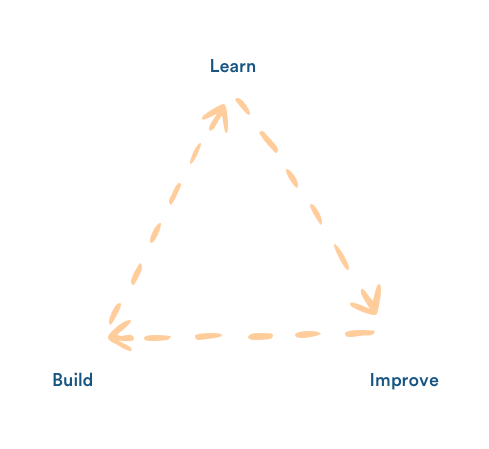
Building new features that benefit sellers is key, but it’s also important to invest in improving the buyer experience.
Focus on improving user experiences at every stage of the customer journey. Consider tweaks to the login process, investigate offering more payment methods, add new ways for customers to discover products, and make the transaction flow and payment process frictionless.
Use software to track customer journeys and identify bottlenecks. Run focus groups or interview customers to better understand their needs and expectations. Improving UX can drive significantly higher conversion rates, benefiting both sellers and the marketplace owner.
Growth doesn’t mean throwing money at every possible opportunity. Identify the most promising tactics, run experiments, then double down on what works.
Some of the most effective growth strategies for marketplaces include:
- Content marketing: Creating valuable content can be one of the most cost-effective ways to attract new users. For inspiration, see how marketplace founder Simon Powell grew with content.
- Marketplace SEO: Optimize your site structure and content for search for a long-term investment that compounds over time.
- Paid media and social: Ads and social campaigns can accelerate growth, but they should be tested carefully to ensure your customer acquisition cost stays healthy.
- Funding: Scaling often requires additional capital. Explore your options in our guide to marketplace funding.
- Word of mouth and PR: Organic buzz is often the strongest growth driver for marketplaces. Encourage referrals with incentives, highlight success stories from your community, and look for opportunities to secure media coverage that amplifies your mission.
Any or all of these tactics might work for your marketplace. Identify the most promising strategies and conduct experiments to understand what works best. Continually iterate and make sure you take a joined-up approach that maximizes marketing spend across channels.
And if you’re scaling on a tight budget, there are plenty of ways to grow your marketplace cost-effectively. The key is to stay disciplined with your metrics: don’t just track headline numbers like users or GMV. Dig into retention, liquidity, and unit economics.
In addition, remember that scaling often requires extra capital. Many successful marketplaces raise funding once they’ve proven strong traction, so they can accelerate growth without compromising on product quality. If you’re considering this path, explore your options in our guide to marketplace funding.
Don’t worry if you don’t hit a home run right away. Identifying the optimal marketing channels for your marketplace is an iterative process. Be creative. Airbnb was on the verge of bankruptcy before launching its infamous breakfast cereal campaign in 2008—an idea that shot it to national prominence.
Once you’ve validated your marketplace idea, it’s time to start setting up your business. There are a few ways to develop a marketplace. Let’s explore three of the most popular:
- Code a site like Etsy from scratch
- Use a multi-vendor e-commerce builder
- Use a dedicated marketplace builder
Coding your marketplace from scratch means you can include whatever features you need. But even if you have advanced front and back-end coding skills, building a marketplace from scratch is a complicated and time-consuming project.
Sharetribe’s senior full-stack developer, Mikko, explores what it takes to code a marketplace platform from scratch in his step-by-step guide.
If you don’t have these skills, outsourced development costs north of $50,000, and will take months to complete.
Launch your Etsy-like platform early, get feedback from early users, and adapt accordingly.
If you’re building a site like Etsy, success lies in serving your core audience better than any other existing solution. It’s important to launch your platform early, get feedback from early users, and adapt accordingly.
Spending months and thousands of dollars building a platform from scratch doesn’t allow you to do this. Entrepreneurs who go this route often risk ending up with an inflexible platform that looks great but doesn’t match their users’ expectations.
Another approach is to combine a standard e-commerce site builder with multi-vendor plugins. Popular e-commerce platforms like Shopify and Magento support this, as do WordPress sites with WooCommerce and Dokan plugins.
This approach can work if you’re building an “online mall” and don’t expect buyers and sellers to interact too much. If you’re familiar with working with these platforms, you’ll get a website up and running much quicker than by coding from scratch.
Usually, however, e-commerce builders won’t be the best fit for marketplaces that need advanced features. As your marketplace grows, users will demand new features. Often, e-commerce builders won’t support them, so you’ll face a tough choice between starting from scratch and building a new site or letting down your users.
Using a multi-vendor e-commerce builder can also present challenges in handling marketplace payments in accordance with online payment regulations. Another challenge is that your whole site will be held together by a network of plugins. Setting them up will take some time and technical skill. Moreover, if one plugin ever goes down or needs an update, your whole business could go offline.
Using marketplace software to create your Etsy-like site has many benefits. The most important one is speed to market. Using a marketplace builder is by far the fastest way to launch—Sharetribe users have launched sites in less than a day.
With no-code marketplace software like Sharetribe, you don’t need technical skills. Our platform handles complex issues like payment frameworks out of the box. All the key features are there without installing plugins or templates. No technical maintenance work is needed, so founders can focus on running and growing their business.
Using a marketplace builder is by far the fastest way to launch.
There are some limitations to keep in mind. For example, Sharetribe doesn’t support a shopping cart out of the box, and the only business model offered in the basic product is a commission-based model. Luckily, most marketplace ideas won’t require these features in the early stages.
Sharetribe’s no-code functionality allows you to launch and run your marketplace without any custom development. However, when you’re ready to start adding custom features to your marketplace, it’s easy to do so with Sharetribe. And you can find a developer partner through Sharetribe’s network of Experts.
If you’re hiring developers to build your site, expect to spend upwards of $50,000 to get a fully functioning site. If you don’t need to outsource the skills, the investment in terms of money will naturally be lower.
But there’s a monetary value to how you spend your energy. The most important resources a marketplace entrepreneur has are their time and focus.
The most important resource a marketplace entrepreneur has is their time.
Fortunately, there are better, more affordable options.
With Sharetribe, you can build your marketplace with no or minimal investment. You get a 14-day free trial of the Build plan, after which you can continue setting up your marketplace at only $39/month. Once you’re ready to invite in actual users, live plan prices start at $99/month, depending on whether you want to onboard supply first or start facilitating transactions right away. Everything is included in the price—there are no surprise maintenance fees or upcharges, and new features are constantly added at no additional cost.
Once you start creating custom functionality, you can switch to a self-hosted Sharetribe marketplace (with the help of a verified Sharetribe developer, if you need one). You continue managing your marketplace in Console and can build just one feature or modify your entire platform. While custom-developing your platform, your developers won’t have to worry about maintenance or performance.
If you don’t have a developer on your team, check out our guide on hiring a marketplace developer for helpful advice.
Getting started with Sharetribe is easy. Want to set up your marketplace today? Here’s how:
- Create your free Sharetribe trial and enter your details.
- Add your marketplace’s name.
- Build your marketplace’s landing page: add a slogan and description that explains what your marketplace does, upload visual assets, and more. Unsplash has great free images, but if you have some budget, check out Stocksy for creative, hand-selected visuals.
- Determine the design of your marketplace: upload a logo and other visual assets, and choose the layout of your search page and listing pages.
- Configure your listing settings, listing fields, and search settings.
- Choose your commission and minimum transaction size.
- Test that everything looks and works to your liking in your Test environment.
- Once everything is ready, it’s time to subscribe!
- Activate online payments by connecting a Stripe or PayPal account. You’ll be able to receive payments and collect commissions straight away.
- Check everything over one last time.
- Congratulations—your Etsy-like site is ready to go. 🚀
For more information on setting up Sharetribe, check out our Help Center or chat with our support team, which is available to help seven days a week.
Once your marketplace starts to grow and users demand more advanced features, you can self-host your front-end application and build any custom functionality on top of Sharetribe’s software.
Sharetribe self-hosted is a headless, API-based marketplace solution that delivers the advanced features required to create a site like Etsy. On top of the essentials, you can build unique user interfaces on web or mobile with infrastructure to support millions of users.
You can save considerable time developing your marketplace by starting development on top of Sharetribe Web Template, our open-source web application, and modifying it to the needs of your Etsy-like platform. You can build just one custom feature your marketplace needs or custom-develop your entire front-end app. And all the while, continue managing your marketplace in Console.
The Marketplace API and Integration API allow you to expand your marketplace indefinitely with custom features and third-party integrations.
Marketplaces get all the essential technologies they need out of the box, giving developers the freedom to build game-changing features for users. There is some development work required, but Sharetribe’s Expert Partners are there to help those who need support.
Building a thriving marketplace like Etsy is a big challenge. But it can be broken down into practical steps that anyone can tackle.
After you’ve validated your idea, you can start using your profits to add features to create better experiences for buyers and sellers. The time you’ve spent learning about your audience pays off multi-fold when you can focus your resources on building features you know users will love.
Experiment with different growth tactics, and once you’ve hit your stride, don’t slow down—continue to add features and invest in further growth.
With Sharetribe, you can have a marketplace up and running in just a few hours. Launch it as fast as possible, and start learning about your idea and audience.
For more help, check out our comprehensive guide on creating a marketplace for more tactics, tips, and ideas, based on over a decade of helping launch more than 1,000 new marketplaces with Sharetribe. You can also browse our customer gallery and founder stories for more inspiration.
Every journey starts with the first step. Take yours today—the world needs more marketplaces!
Let’s answer some of the most common questions about how to build a website like Etsy.
Yes. With modern no-code marketplace software like Sharetribe, you can launch an Etsy-style marketplace without writing a single line of code.
All the core features—listings, profiles, payments, messaging, reviews—are ready to go out of the box. As you grow, you can customize further with APIs or bring in developers later if needed.
There’s no single right answer, but most handmade marketplaces succeed with low, transparent fees. For reference, Etsy charges a $0.20 listing fee plus a 6.5% transaction fee.
A good starting point is to keep your commission under 10%, so sellers feel they’re keeping most of their earnings while you still cover operational costs.
You need clear policies against counterfeit goods and copyrighted content. Many marketplaces use a “notice and takedown” process where rights holders can report infringements, and the platform removes flagged items.
To build trust, combine clear rules with proactive monitoring and a reporting system for buyers and sellers.
In most cases, a responsive website is enough at launch. Mobile-optimized websites work seamlessly on smartphones and tablets, and they’re much cheaper and faster to build than a native app.
You can always invest in a mobile app later once your marketplace has proven traction and demand.
Amazon has made its logistics network famous, but you don’t need to replicate that system to build a successful marketplace like Etsy. In most handmade marketplaces, sellers handle their own shipping using standard carriers like USPS, UPS, or local couriers.
As a founder, your role is to make shipping as smooth as possible by:
- Offering prepaid label integrations if you can
- Sharing best practices for packaging and delivery times
- Encouraging clear communication between sellers and buyers about shipping status
This approach keeps your marketplace lean and focused, without the massive cost and complexity of building an Amazon-style fulfillment network.
Start your 14-day free trial
Create a marketplace today!
- Launch quickly, without coding
- Extend infinitely
- Scale to any size
No credit card required
